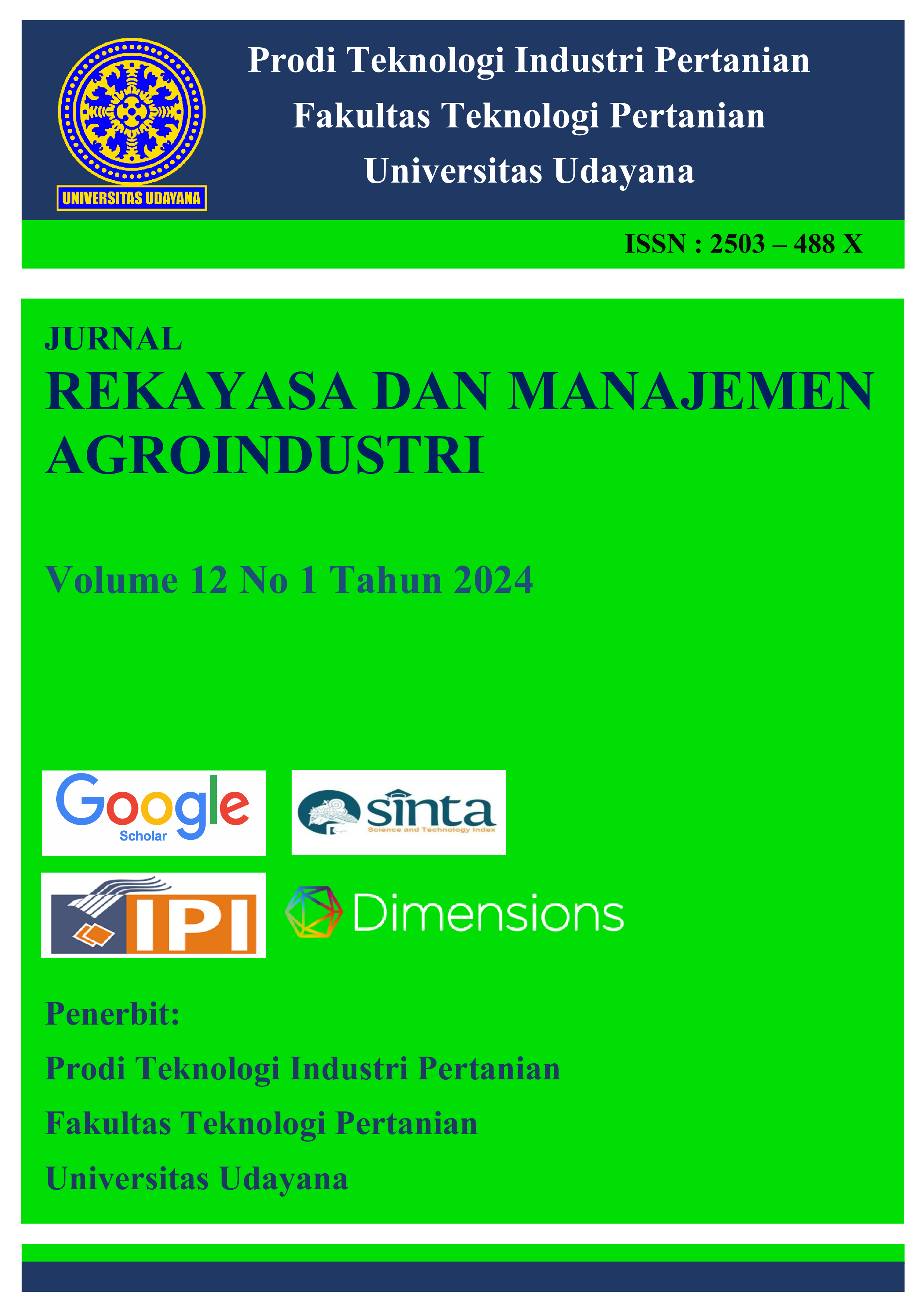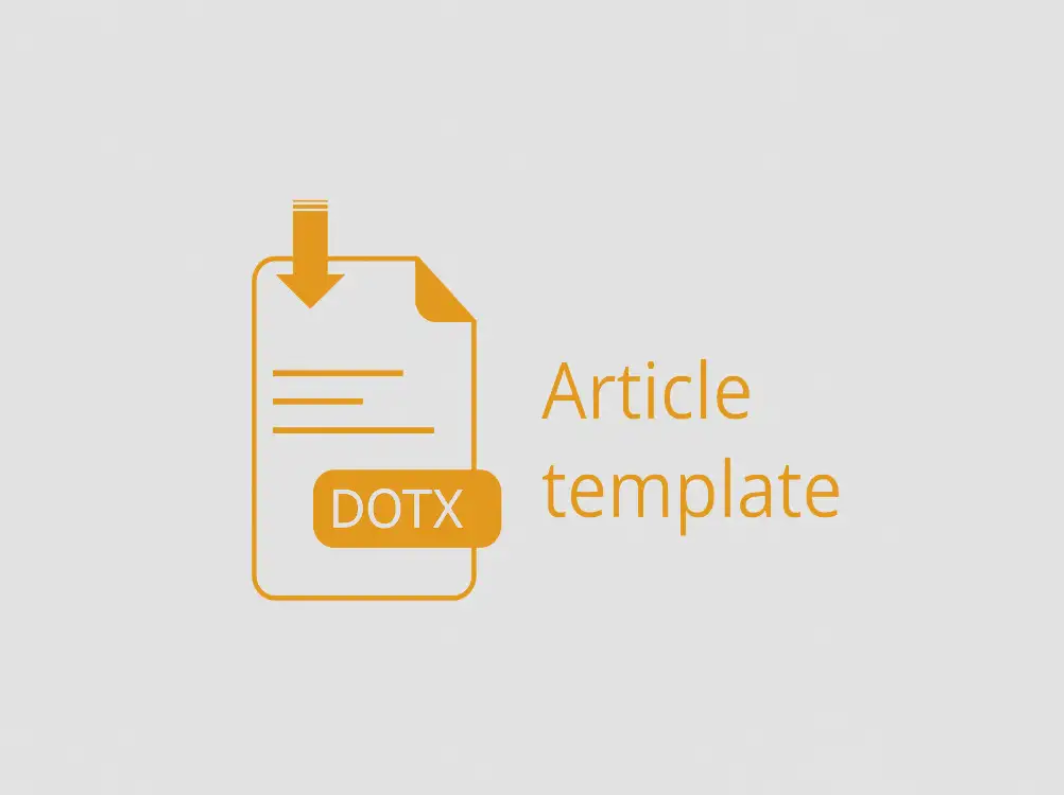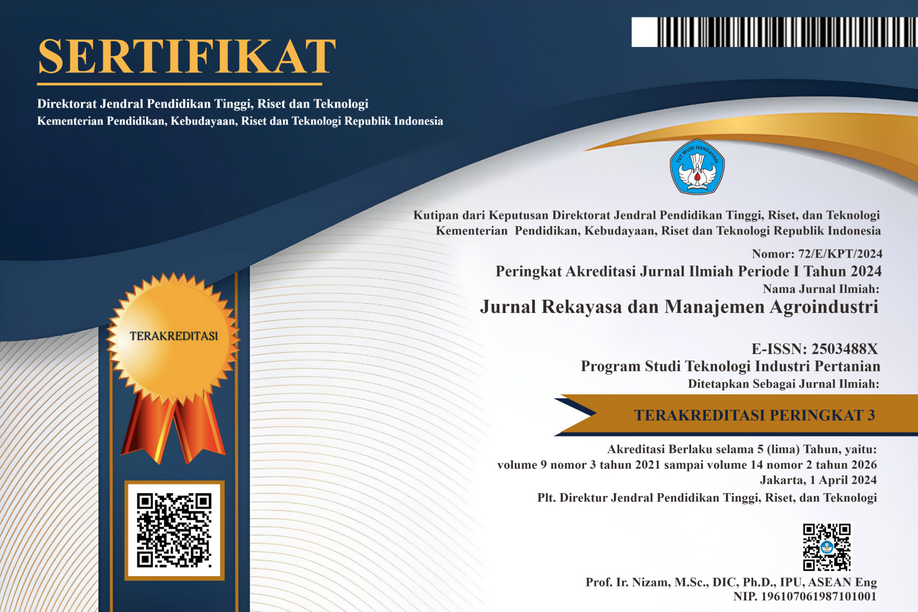Karakteristik Hidrogel Kitosan pada Variasi Nanoselulosa
Abstract
This research purpose to find out the effect of the varying of concentrations of nanocellulose on the characteristics chitosan-based hydrogel and determine the optimal nanocellulose concentration to yield the best chitosan based hydrogel characteristics. Factorial randomized block design was applied in this research, with single variable which was varying nanocellulose concentrations (0, 1, 2, 3, and 4%), with three grouping. The variable observed were thickness, tensile strength, Young’s modulus, elongation at break, adsorption, and scanning electron microscopy (SEM). The result shows that the variation of nanocellulose concentration has significant effect on thickness, tensile strength, Young’s modulus, elongation at break, and adsorption of hydrogel. Based on the research result, the best variable for this research is 4 % b/v nanocellulose, with the value 0,52±0,07 mm thickness, 4,02±0,17 MPa tensile strength, 3,93±0,01% elongation, 106,51±26,80 MPa young modulus, and 238±0,23%. adsorption. The result of scanning electron microscope (SEM) analysis illustrates that the surface morphology of the chitosan hydrogel with nanocellulose concentration is rougher compared to without nanocelllose.
Keywords : Hydrogel, Chitosan,Nanocellulose, Glutaraldehyde, Glycerol.
Penelitian ini bertujuan untuk mengetahui pengaruh variasi konsentrasi nanoselulosa terhadap karakteristik hidrogel kitosan dan menentukan konsentrasi nanoselulosa yang tepat untuk menghasilkan karakteristik hidrogel kitosan terbaik. Penelitian ini menggunakan rancangan acak kelompok (RAK) dengan satu perlakuan yaitu variasi konsentrasi nanoselulosa (0, 1, 2, 3, dan 4%) dengan tiga kelompok percobaan. Variabel yang diamati adalah ketebalan, kuat tarik, modulus young, elongasi, adsorpsi, dan scanning electron microscopy (SEM). Hasil penelitian menunjukkan bahwa variasi konsentrasi nanoselulosa berpengaruh sangat nyata terhadap ketebalan, kuat tarik, modulus young, elongasi, dan adsorpsi hidrogel. Berdasarkan hasil penelitian, perlakuan terbaik yaitu 4% b/v nanoselulosa dengan nilai ketebalan 0,52±0,07 mm, kuat tarik 4,02±0,17 MPa, elongasi 3,93±0,01%, modulus young 106,51±26,80 MPa, dan adsorpsi 238±0,23%. Hasil analisis scanning electron microscope (SEM) pada perlakuan terbaik menunjukan bahwa morfologi permukaan hidrogel kitosan dengan konsentrasi nanoselulosa lebih kasar dibandingkan tanpa nanoselulosa.
Kata kunci : Hidrogel, Kitosan, Nanoselulosa, Glutaraldehid, Gliserol.
Downloads
References
Agustina, A., Cahyaningtyas, Amalia, B., Pudjiastuti, W., Melanie, S., Fauzia, V., and Imawan, C. 2019. Effect of glutaraldehyde to the mechanical properties of chitosan/nanocellulose. Journal of Physics: Conference Series, 1317(1), 0–8. https://doi.org/10.1088/1742-6596/1317/1/012045
Ahmed, F. 2017. Morphology and mechanical properties of nanocrystalline cellulose reinforced chitosan based nanocomposite. Global Journal of Chemistry, 3(1), 2454–2490.
Aleksi, H., Essi, S., Inari, L., Timo, S., Minna, K., and Sampo, T. 2018. Nanocellulose and chitosan based films as low cost, green piezoelectric materials. Carbohydrate Polymers, 202(1), 418–424.
Arianita, A., Cahyaningtyas, Amalia, B., Pudjiastuti, W., Melanie, S., Fauzia, V., and Imawan, C. 2019. Effect of glutaraldehyde to the mechanical properties of chitosan/nanocellulose. Journal of Physics: Conference Series, 1317(1). https://doi.org/10.1088/1742-6596/1317/1/012045
Bakhori, A. 2017. Tinjauan aspek korosi pada makanan dalam kemasan kaleng. PISTON (Jurnal Ilmiah Teknik Mesin Fakultas Teknik UISU), 2(1).
Bangar, S. P., and Whiteside, W. S. 2021. Nano-cellulose reinforced starch bio composite films- A review on green composites. International Journal of Biological Macromolecules, 185(July), 849–860. https://doi.org/10.1016/j.ijbiomac.2021.07.017
Bashir, S., Hina, M., Iqbal, J., Rajpar, A. H., Mujtaba, M. A., Alghamdi, N. A., Wageh, S., Ramesh, K., and Ramesh, S. 2020. Fundamental concepts of hydrogels: Synthesis, properties, and their applications. In Polymers (Vol. 12, Nomor 11). https://doi.org/10.3390/polym12112702
Catoira, M. C., Fusaro, L., Di Francesco, D., Ramella, M., and Boccafoschi, F. 2019. Overview of natural hydrogels for regenerative medicine applications. Journal of Materials Science: Materials in Medicine, 30(10). https://doi.org/10.1007/s10856-019-6318-7
Chamidah, N., and Rohmawati, L. 2022. Pengaruh konsentrasi ekstrakdaun sirih hijau dan madu terhadap sifat antibakteri plester luka hidrogel PVA/kitosan. Jurnal Inovasi Fisika Indonesia (IFI), 48–55.
Falamarzpour, P., Behzad, T., and Zamani, A. 2017. Preparation of nanocellulose reinforced chitosan films, cross-linked by adipic acid. International Journal of Molecular Sciences, 18(2), 1–12. https://doi.org/10.3390/ijms18020396
Fardioui, M., Mekhzoum, M. E. M., Qaiss, A. el K., and Bouhfid, R. 2016. Bionanocomposite materials based on chitosan reinforced with nanocrystalline cellulose and organo-modified montmorillonite. Engineering Materials, 167–194. https://doi.org/10.1007/978-981-10-1953-1_7
Fernandes, S., Freire, C. M., Silvestre, C. S. R., Neto, A. J. D., Gandini, C., Pascoal, A., Berglund, L. A., and Salmén, L. 2010. Transparent chitosan films reinforced with a high content of nanofibrillated cellulose. Carbohydrate Polymers, 81(2), 394–401.
George, J., and Siddaramaiah. 2012. High performance edible nanocomposite films containing bacterial cellulose nanocrystals. Carbohydrate Polymers, 87(3), 2031–2037. https://doi.org/10.1016/j.carbpol.2011.10.019
Giri, T. K., Thakur, A., Alexander, A., Ajazuddin, Badwaik, H., and Tripathi, D. K. 2012. Modified chitosan hydrogels as drug delivery and tissue engineering systems: present status and applications. Acta Pharmaceutica Sinica B, 2(5), 439–449. https://doi.org/10.1016/j.apsb.2012.07.004
Hamidreza, T., Faramarz, A. G., and Alireza, A. 2021. The effect of nanocellulose on mechanical and physical properties of chitosan-based biocomposites. Journal of Elastomers and Plastics, 54(1).
Hisbiyah, A., Nurfadlilah, L., and Nisyak, K. 2023. The nanocellulose addition’s effect on chitosan composites mechanical properties and antibacterial activity against S. aureus. AIP Proceedings, 2554(1).
Istiqomah, N. 2012. Pembuatan hidrogel kitosan-glutaraldehid untuk aplikasi penutup luka secara in vivo. Universitas Airlangga.
Jia, Y., Wang, X., Huo, M., Zhai, X., Li, F., and Zhong, C. 2017. Preparation and characterization of a novel bacterial cellulose/chitosan bio-hydrogel. Nanomaterials and Nanotechnology, 7, 1–8. https://doi.org/10.1177/1847980417707172
Kumar, P. T. S., Raj, N. M., Praveen, G., Chennazhi, K. P., Nair, S. V., and Jayakumar, R. 2013. In vitro and in vivo evaluation of microporous chitosan hydrogel/nanofibrin composite bandage for skin tissue regeneration. Tissue Engineering - Part A, 19(3–4), 380–392. https://doi.org/10.1089/ten.tea.2012.0376
Li, Q., Zhou, J., and Zhang, L. 2009. Structure and properties of the nanocomposite films of chitosan reinforced with cellulose whiskers. Wiley InterScience, 47(11).
Nautilius, I. ., Arnata, I. ., and Wijaya, I. . M. 2022. The effect of variation of additional glutaraldehyd and glycerol on characteristics of chitosan hydrogel. 10(4), 422–431.
Nikolić, L. B., Zdravković, A. S., Nikolić, V. D., and Ilić-Stojanović, S. S. 2019. Synthetic hydrogels and their impact on health and environment. 1363–1391. https://doi.org/10.1007/978-3-319-77830-3_61
Peers, S., Montembault, A., and Ladavière, C. 2020. Chitosan hydrogels for sustained drug delivery. Journal of Controlled Release, 326, 150–163. https://doi.org/10.1016/j.jconrel.2020.06.012
Purwatiningsih, S., Wukirsari, T., Sjahriza, A., and Wahyono, D. 2009. Kitosan sumber biomaterial masa depan.
Rudyardjo, D. I. 2014. The effect of addition glycerol as plasticier to the characteristics of chitosan-glutaraldehyde hydrogel for wound dressing application. Jurnal Ilmiah Sains, 14(1), 18–28.
Rudyardjo, D. I., and Wijayanto, S. 2017. The synthesis and characterization of hydrogel chitosan-alginate with the addition of plasticizer lauric acid for wound dressing application. Journal of Physics: Conference Series, 853(1). https://doi.org/10.1088/1742-6596/853/1/012042
Sari, M. 2021. Karakterisasi komposit penyembuh luka dari kitosan-pektin ekstrak batang pisang kepok ( Musa paaadisiaca. Linn) melalui uji invitro dan invivo.
Shi-Neng, L., Baoqiang, L., Gong, L.-X., Zhi-Ran, Y., Yujie, F., Dechang, J., Yu, Z., and Long-Cheng, T. 2018. Enhanced mechanical properties of polyacrylamide/chitosan hydrogels by tuning the molecular structure of hyperbranched polysiloxane. Material Design, 18(7).
Trache, D., Tarchoun, A. F., Derradji, M., Hamidon, T. S., Masruchin, N., Brosse, N., and Hussin, M. H. 2020. Nanocellulose: From Fundamentals to Advanced Applications. In Frontiers in Chemistry (Vol. 8, Nomor May). https://doi.org/10.3389/fchem.2020.00392
Wahba, M. I. 2020. Enhancement of the mechanical properties of chitosan. Journal of Biomaterials Science, Polymer Edition, 31(3), 350–375. https://doi.org/10.1080/09205063.2019.1692641
Wivanius, N., and Budianto, E. 2015. Sintesis dan karakterisasi hidrogel superabsorben kitosan poli(N-vinilkaprolaktam) (Pnvcl) dengan metode full IPN (Interpenetrating Polymer Network). Pharmaceutical Sciences and Research, 2(3), 152–168. https://doi.org/10.7454/psr.v2i3.3483
Yu, F., Yang, P., Yang, Z., Zhang, X., and Ma, J. 2021. Double-network hydrogel adsorbents for environmental applications. Chemical Engineering Journal, 426(August), 131900. https://doi.org/10.1016/j.cej.2021.131900
Zhao, K., Wang, W., Teng, A., Zhang, K., Ma, Y., Duan, S., Li, S., and Guo, Y. 2020. Using cellulose nanofibers to reinforce polysaccharide films: Blending vs layer-by-layer casting. Carbohydrate Polymers, 227(September 2019). https://doi.org/10.1016/j.carbpol.2019.115264

Ciptaan disebarluaskan di bawah Lisensi Creative Commons Atribusi-BerbagiSerupa 4.0 Internasional.
Seluruh artikel di Jurnal ini dapat disebarluaskan atas tetap mencantumkan sumber yang syah. Identitas judul artikel tidak boleh dihilangkan. Penerbit tidak bertangggung jawab terhadap naskah yang dipublikasikan. Isi artikel menjadi tanggung jawab Penulis.














